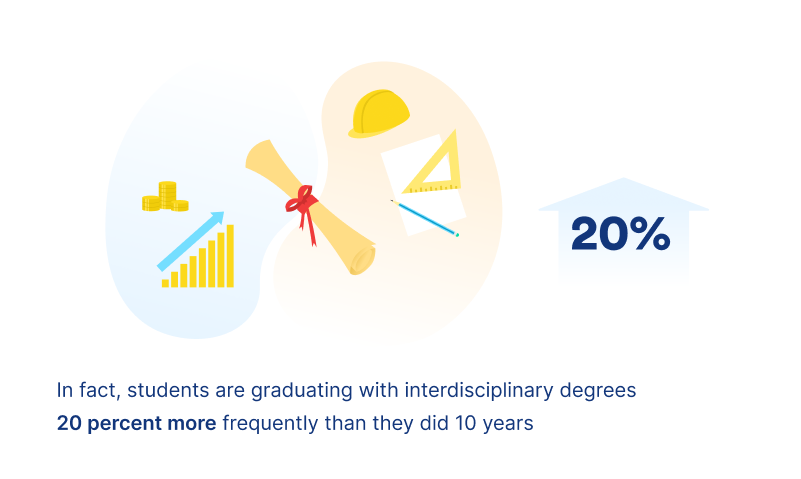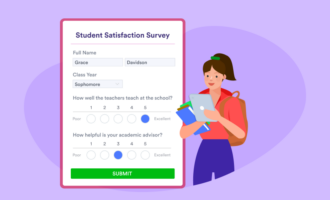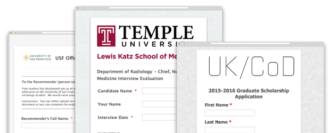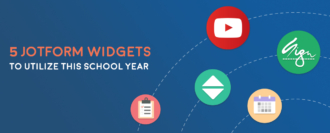8 best higher education trends to watch
- Cost factors hit a tipping point
- Student power peaks
- Bite-sized credentialing and micro-education rules
- A diversity explosion fuels the global campus
- Choose your own education
- A turn toward teaching emerges
- Immersive learning accelerates
- Tech lands on campus
It’s no surprise that U.S. university enrollment has struggled to recover from COVID-19. Enrollment dropped off during lockdowns, with over 20 percent fewer students enrolling straight from high school in fall 2020 than the year before.
However, most administrators expected students to return to classrooms when the crisis ended. They haven’t. Instead, the pandemic accelerated declines that have progressed for over a decade, starting in 2012 and hitting crisis levels during the height of remote education.
Other trends are impacting higher education, too. From international recruiting to a location-based tech revolution, here are eight trends to watch — and how higher education professionals can meet these challenges in 2024.
1. Cost factors hit a tipping point
It all started with the Great Recession of 2008. States cut spending on post-secondary institutions, leaving students to make up the difference. At the same time, U.S. families had half a million fewer children.
Fast forward 18 years.
Fewer students from this small cohort attend university than ever, down to roughly 62 percent of the nation’s high school graduates (from a high of 70 percent in 2009). That’s led colleges to make up the enrollment shortfall, with tuition rising at twice the cost of living. The result? Even fewer students decide to enroll.
It all adds up to fewer students and high competition at a time when administrative costs also hit new highs. And here’s a warning: We’re still three years away from the first Great Recession babies heading to college. In the meantime, expect heightened competition among post-secondary institutions, with marketing budgets stretched more than ever, and a glut of new entrepreneurial ideas designed to make schools profitable.
2. Student power peaks
One way to entice new students is to ask them exactly what they want and provide it. You’ll see more and more hybrid and remote offerings. You’ll also be more likely to find flexible and asynchronous learning formats built to accommodate a more diverse array of learners, including people who are already in the workforce. Some trends we’ve seen include:
- Allowing students to work outside of a semester schedule
- Eradicating general education requirements
- Offering year-round programs that get students into the job market faster
- Reimagining in-person education with a “low-residency” option
Similarly, universities are increasingly leaning into interdisciplinary, team-taught, self-taught, and cross-department courses, unique majors, and individualized combinations. In fact, students are graduating with interdisciplinary degrees 20 percent more frequently than they did 10 years ago.
You’ll also see universities strike out into less practical areas to cater to student desires. That includes offering perks like the University of Northern Colorado’s pet-friendly student housing or MIT’s residence hall ball pit. With fewer students in their pipelines, creative approaches to meeting students’ desires will continue to dominate.
3. Bite-sized credentialing and micro-education rules
Part of students’ newfound clout comes from the reality that fewer high school graduates are pursuing a college education. When asked, 56 percent of Americans in 2023 said a four-year degree wasn’t worth the cost.
There are more alternatives for high school graduates. For example, the average cost of coding boot camps is less than $11,000, with some providing guaranteed job placement. They also take a fraction of the time students spend on four-year degrees.
Further, universities take an average of six years and over $2 million to develop a course of study in a world where job roles and industries seem to be changing overnight. By the time a university offers a new major, students are already afraid it could be obsolete on the job market.
Universities are increasing the smorgasbord of small, up-to-the-minute credentials they provide. Rather than a four-year course of study with a nebulous payoff, “unbundling” capitalizes on the premise students are more likely to opt for a short course with an immediate credential and a clear benefit. And like the industry-disrupting unbundling of cable TV services, it can be both a concern and an opportunity for the universities watching this trend. Nevertheless, expect institutions to keep pushing to meet student worries about cost by offering more credentials for upskilling or career advancement.
4. A diversity explosion fuels the global campus
Since the economic costs of college-educated faculty and staff are only rising, universities are looking for higher tuition from out-of-state and international students. Consequently, they compete with other universities for these coveted applications and increasingly shift their offerings to appeal to a global cohort (and a more internally diverse student body, as evidenced by more flexible coursework).
Feeling more welcome, the number of international students on U.S. campuses has increased steeply in the 2010s, nearly doubling in number from 2003-2004. Schools have responded with increased digital marketing internationally, partnerships with other universities to recruit abroad, and offering student ambassadors ready to chat or share videos about their experience.
With more than a million students in the country for the first time since the pandemic started, 2024 is the year that universities can build momentum and solidify their recruitment channels.
5. Choose your own education
In October 2023, just over a third of Americans said they had “a great deal” or “quite a lot” of confidence in post-secondary education. That’s not very many, representing a decline from just a few years ago. As students compare universities, they increasingly demand a highly personalized education, not a cookie-cutter experience.
One futuristic suggestion is to provide AI-based support systems for lower-performing students throughout the semester: AI can help give personalized feedback, increasing individual attention and engagement while minimizing drop-out and failure rates. Look at the University of Michigan’s MWrite program, which uses AI to allow students in large classes to complete writing-intensive assignments and get personal feedback on their work.
6. A turn toward teaching emerges
While universities focus more and more on scalable profitability, another, opposing trend is at work: greater student demand for a personalized education. As a result, the decades-long reliance on adjunct and contingent faculty is beginning to weaken as professors’ expertise starts to show its worth.
After all, as universities compete for students, they must also tout the personalization students demand. That might come in the form of showing off high university rankings, which require rockstar researchers (expensive, but not necessarily tied to improved teaching) or low student-to-teacher ratios (expensive). It might include office hours, small group discussions, and fewer graduate assistants taking on entire course sections. It may also be that, with fewer students believing a college education can help them get ahead, universities with their own “servant class” of instructors can simply confirm student fears that education doesn’t pay.
With 12 contingent faculty strikes this year and the pandemic’s Great Resignation hitting academia, universities are even more aware that meeting student needs starts with fostering one-of-a-kind relationships with mentors who aren’t too busy dashing off to their second jobs.
7. Immersive learning accelerates
Providing students with better learning experiences doesn’t have to fall entirely on the shoulders of faculty.
VR and AR-augmented tools are flooding onto campuses to bridge the gap. From programs that offer stress-free public speaking instruction to digital archaeology, universities are finding ways to increase student understanding with headsets and digital partnerships. Take the Giza Project, headquartered at Harvard but incorporating artifacts from archives across Africa, Europe, and North America.
Confined initially to fields like anatomy, expect to see AR and VR exploding across curricula to help students test hypotheses, examine artifacts, and view distant places. If you haven’t explored how your students can have virtual conversations in foreign languages or get a cockpit view of the 1943 Berlin air raid, you surely will soon.
8. Tech lands on campus
Students are used to accessing campus resources through digital platforms like Moodle and Blackboard. They’re also seeing new technology deployed in person and all around campus.
For instance, do your students carry ID cards that open particular doors, allow them to pay for food and services, check out library books, and even get them on the local bus? Do they download public safety apps that allow them to upload videos and report crimes while pinpointing their location and remaining anonymous?
And if a natural disaster or safety issue occurs on campus, are students who enter specific areas notified of a problem by text?
Universities are even getting on board to install sensors that safeguard campus buildings, setting off alarms when an unauthorized visitor enters and identifying troubling behavior from visitors right when it starts. Sensors can identify gunfire, adjust the temperature, detect floods, and track how students use rooms so that universities can add more resources or redesign features.
From keeping track of campus equipment to identifying threats, the “smart campus” is only getting bigger in 2024.
Conclusion
Many of 2024’s trends emerged from the investment in digital solutions that COVID-19 lockdowns helped accelerate. With new tools in their tool belts, it’s only natural that university administrators are using them to try to solve more recent challenges. Addressing the so-called “enrollment cliff” and doubling down on technology is foremost on their minds.
After all, moving more university functions online is a simple way to meet student needs efficiently. With Jotform Enterprise for education, students can submit scholarship applications, check in for academic advising, evaluate courses, and more in a simple, safe, online way. Plus, submitted data can go straight to your customer relationship management (CRM) tool with integrations that keep your university’s tech life running smoothly.
With tools like Jotform, you’ll be better equipped to meet the challenges of the coming year and beyond.












































































































Send Comment: